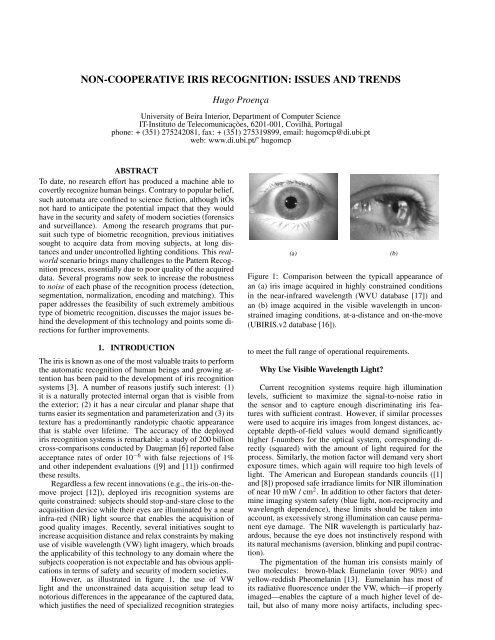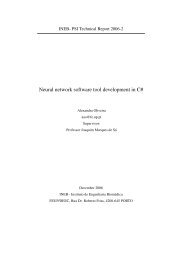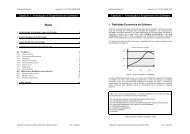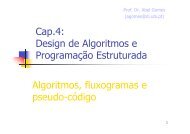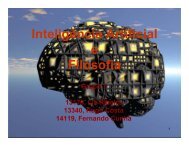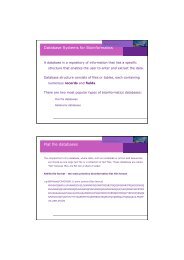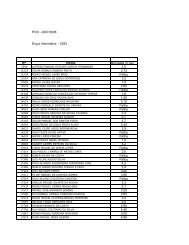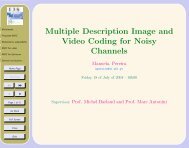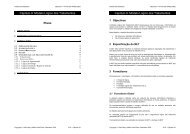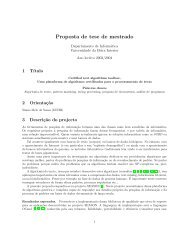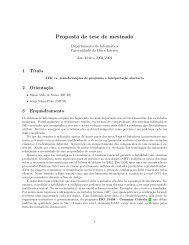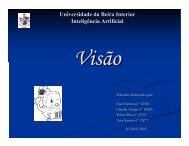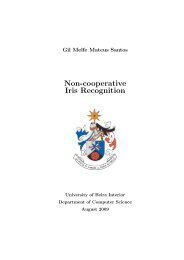non-cooperative iris recognition: issues and trends - UBI
non-cooperative iris recognition: issues and trends - UBI
non-cooperative iris recognition: issues and trends - UBI
Create successful ePaper yourself
Turn your PDF publications into a flip-book with our unique Google optimized e-Paper software.
Figure 2: Spectral radiance of the human <strong>iris</strong> according tothe levels of <strong>iris</strong> pigmentation [10].(a)ular <strong>and</strong> diffuse reflections <strong>and</strong> shadows. Also, the spectralradiance of the <strong>iris</strong> in respect of the levels of its pigmentationvaries much more significantly in the VW than in the NIR(Figure 2). These optical properties are the biological rootsbehind the higher heterogeneity of the VW <strong>iris</strong> images, whencompared to the traditional NIR data.2. NON-COOPERATIVE ACQUISITIONFRAMEWORKThe initial task comprised the construction of a data set ableto be used in all subsequent experiments. Thus, the majorpurpose of the <strong>UBI</strong>RIS.v2 [16] data set is to constitute atool to evaluate the feasibility of VW <strong>iris</strong> <strong>recognition</strong> under<strong>non</strong>-ideal conditions. The various types of degraded images,imaging distances, subject perspectives <strong>and</strong> lighting conditionson this database are of strong utility in the specificationof the VW <strong>iris</strong> <strong>recognition</strong> feasibility <strong>and</strong> constraints. Figure3a gives a global perspective of the acquisition framework<strong>and</strong> of the environment the <strong>UBI</strong>RIS.v2 data set wascollected. In order to disburden the imaging sessions for volunteers<strong>and</strong> maximize the number of usable images per subject,we decided to perform data acquisition manually. Inthe meanwhile, a completely automated acquisition frameworkwas devised, being composed by two commercial webcameras, a pan-<strong>and</strong>-tilt device <strong>and</strong> an high resolution camera(Figure 3b). The process starts by a software module thatperforms the detection of human silhouettes, according to thedata acquired from one of the web cameras. Using this information<strong>and</strong> a set of semantic rules, a region of the scene iscropped <strong>and</strong> given to the real time face detector module (accordingto the well known method of Viola <strong>and</strong> Jones [18]).This phase gives the 2D position (x,y) of a face in the scene,which is sent to a stereo vision module that collects data fromboth web cameras <strong>and</strong> infer the subject depth in the scene,i.e., the distance z between the acquisition camera <strong>and</strong> thesubject. Using the pan-<strong>and</strong>-tilt device, the acquisition camerais directed to the 3D scene point at coordinates (x,y,z) <strong>and</strong> animage that contains approximately the region of the subject’shead is captured. Finally, using a set of biologically-basedsemantic rules, a region that contains the subject’s eyes iscropped <strong>and</strong> used in the biometric <strong>recognition</strong> phases.As illustrated in Figures 4 <strong>and</strong> 5, images of the<strong>UBI</strong>RIS.v2 data set are degraded by several factors <strong>and</strong> arehighly heterogeneous, regarding the lighting conditions ofthe environment. Through visual inspection, fourteen differentfactors were detected <strong>and</strong> classified into one of two(b)Figure 3: Overview of the image acquisition frameworks (a)used to collect the <strong>UBI</strong>RIS.v2 data set (A,B: cameras; C,D:light sources; E: subject <strong>and</strong> (b) used to perform automaticimage acquisition, with similar labels to the manual configuration.major categories: local or global, as they affect exclusivelyimage regions or the complete image. The local categorycomprises <strong>iris</strong> obstructions, reflections, off-angle <strong>and</strong> partialimages, while the global comprises poor focused, motionblurred,rotated, improper lighting <strong>and</strong> out-of-<strong>iris</strong> images.Figure 4: Example of a sequence of close-up <strong>iris</strong> images acquiredat different distances (between eight <strong>and</strong> four meters),on a moving subject <strong>and</strong> under dynamic lighting conditions.3. RECOGNITION SPECIFICITYPrevious works had reported an almost infinitesimal probabilityof producing a false match in comparing signaturesextracted from good quality data (e.g., [7], [4], [9] <strong>and</strong> [11]),which is due to the chaotic appearance of the <strong>iris</strong> texture <strong>and</strong>regarded as one of the technology’s major advantages, whencompared to other biometric traits. This section goes onestep beyond <strong>and</strong> analyzes the probability of producing falsematches when comparing degraded <strong>iris</strong> samples (or from par-
(a) Good quality <strong>iris</strong> image. (b) Off-angle <strong>iris</strong> image. (c) Poor focused <strong>iris</strong> image. (d) Rotated <strong>iris</strong> image. (e) Motion-blurred <strong>iris</strong> image.(f) Iris obstructions due to eyelids.(g) Iris obstructions due to eye-(h) Iris obstructions due to glasses.(i) Iris obstructions due to contact(j) Iris obstructions due to hair.lashes.lenses.(k) Iris imaging in poor lightingconditions.(l) Iris with specular reflections. (m) Iris with lighting reflections. (n) Partial captured <strong>iris</strong>. (o) Out-of-<strong>iris</strong> image.Figure 5: Comparison between a good quality image (Figure 5a) <strong>and</strong> several types of <strong>non</strong>-ideal images of the <strong>UBI</strong>RIS.v2database. These images resulted of less constrained imaging conditions, under varying lighting conditions, at-a-distance <strong>and</strong>on-the-move subjects.tial or <strong>non</strong>-<strong>iris</strong> regions due to failures on the eye detection<strong>and</strong> segmentation modules). This hypothesis was tested usingthe <strong>recognition</strong> method proposed by Daugman [7] - composedby <strong>iris</strong> segmentation, normalization, encoding (bidimensionalGabor wavelets) <strong>and</strong> matching (Hamming distance)- we extracted 1 000 signatures from <strong>UBI</strong>RIS.v2 imageswith good quality. Then, we extracted a set of signaturesfrom 1 000 degraded images, 10 000 <strong>non</strong>-<strong>iris</strong> or partial <strong>iris</strong>images <strong>and</strong> 10 000 natural <strong>and</strong> synthetic textures. Finally,using an ’one against all comparison scheme, we performeda total of 21 000 000 comparisons between signatures. Duringthese tests we didn’t get a single dissimilarity value closeto the usual acceptance threshold (0.33), which means thatnot even a single false acceptance was observed if the traditionalacceptance thresholds are used. Figure 6 gives thehistogram of the obtained dissimilarity values (vertical bars)<strong>and</strong> the approximated Gaussian distribution (line plot withµ = 0.49992 <strong>and</strong> σ = 0.02419). We confirmed that, even onhighly degraded data, the used <strong>iris</strong> encoding <strong>and</strong> comparisonstrategies produce a false match with almost null probability.Based on the parameters of the fitted Gaussian distribution,the probability of producing a dissimilarity value lower than0.33 will be approximately of 1.03923 × 10 −12 . Once again,the role of this value for the type of <strong>recognition</strong> discussed inthis paper should be stressed: it can be assumed with extremeconfidence that <strong>non</strong>-<strong>cooperative</strong> <strong>recognition</strong> systems will notproduce false matches <strong>and</strong> — thus — any match reported hasa full probability of being genuine.Figure 6: Histogram of the obtained dissimilarities whencomparing signatures extracted from 1 000 templates withgood quality <strong>and</strong> 21 000 signatures extracted from <strong>iris</strong> imageswith bad quality, partial <strong>iris</strong>es <strong>and</strong> <strong>non</strong>-<strong>iris</strong> data. ”Rsquare”gives the goodness-of-fit of the plotted Gaussian distributionwith µ = 0.499 <strong>and</strong> σ = 0.024 to the obtained results.4. RECOGNITION SENSITIVITYAs above stated, the uncontrolled acquisition setup leads todata with heterogeneous quality. In this scope, quality assessmentis a fundamental task: the goal is to quantify char-
acteristics <strong>and</strong> fidelity of the segmented data, particularly interms of its utility. This is essential, as performing <strong>recognition</strong>in too much degraded data decreases matching accuracy<strong>and</strong> increases computational complexity.According to the afore observations, this section aims atgiving an approximation of the <strong>recognition</strong> rates that <strong>non</strong><strong>cooperative</strong><strong>iris</strong> <strong>recognition</strong> systems would achieve, accordingto the quality of the used data. Again, we used the classicalDaugman’s <strong>recognition</strong> strategy [7] for our experiments<strong>and</strong>, according to this choice, the <strong>iris</strong> boundaries were normalizedto dimensionless polar coordinates. Then, a bank ofGabor filters was used to analyze the <strong>iris</strong> texture <strong>and</strong> the angleof each phasor quantized to one of four quadrants. Finally,the fractional Hamming distance gave the dissimilarity betweentwo <strong>iris</strong>es. A subset of 10 427 <strong>UBI</strong>RIS.v2 images wasselected, which under visual inspection we verified that thesegmentation method has accurately segmented. For comprehensibility,we refer to a <strong>recognition</strong> test when each sampleof a data set is matched against all the remaining imagesof the the same data set, resulting in two types of comparisons:intra-class (genuine) <strong>and</strong> inter-class (impostor). Assuggested by Daugman [5], for two-choice decisions the decidabilityindex d ′ measures how well separated are the twotypes of distributions <strong>and</strong> <strong>recognition</strong> errors correspond totheir overlap area:d ′ = |µ E − µ I |√(1)12 (σ I 2 + σ E 2) where µ I <strong>and</strong> µ E are the means of the two distributions<strong>and</strong> σ I <strong>and</strong> σ E their st<strong>and</strong>ard deviations.Figure 7 compares the histograms of the fractional Hammingdistances for the genuine (light bars) <strong>and</strong> impostor(dark bars) comparisons obtained when all images were usedin the <strong>recognition</strong> test (Figure at the far left) <strong>and</strong> when thepoorest quality samples (according to the visual perceptionof quality) were rejected (Figure at the center). The line plotscorrespond to the fitted Normal distributions <strong>and</strong> the upperleft corner gives the corresponding decidability index d ′ . Asgeneral considerations, we confirmed that values obtained forthe impostor distributions do not significantly vary accordingto the quality of the data <strong>and</strong> are almost the same reported forthe NIR constrained <strong>recognition</strong> setups. Oppositely, there isa significant movement of the genuine distributions towardthe impostors, substantially decreasing the sensitivity of thesystem, if traditional acceptance thresholds are used. Dueto this, the decidability of the VW <strong>recognition</strong> systems significantlyvaried. Figure 7c shows how the true <strong>and</strong> falsematches in our system would change according to differentdecision thresholds, when no quality is considered (continuousline) <strong>and</strong> when only samples with good quality are consideredfor <strong>recognition</strong> (dashed line). Here, we plot the areaunder curve (AUC) for both setups, which significantly augmentsas the poorest quality samples are rejected.5. CONCLUSIONS AND DIRECTIONSThe possibility of performing automatic <strong>recognition</strong> of humanbeings in uncontrolled environments <strong>and</strong> without requiringthem any type of cooperation is of evident interestor forensic <strong>and</strong> security purposes <strong>and</strong> represents a gr<strong>and</strong>challengefor the pattern <strong>recognition</strong> community. This paperdiscussed the use of VW light to acquire <strong>iris</strong> images frommoving subjects without requiring them any active participation<strong>and</strong> the potential use of such data to perform biometric<strong>recognition</strong>. We presented the main characteristics ofa data set that is free available for the research community(<strong>UBI</strong>RIS.v2), <strong>and</strong> highlighted some of the <strong>issues</strong> behind thedevelopment of this type of <strong>recognition</strong>.Due to the evident impact that the type of <strong>recognition</strong> discussedin this paper would have in modern societies, multipleresearch efforts are now putted in the development of suchtechnology. Among those, there is an extremely promisingnew type of biometric <strong>recognition</strong> called periocular biometricsthat refers to the regions in the immediate vicinity of theeye (Figure 8) <strong>and</strong> attempts to perform <strong>recognition</strong> based notonly in the <strong>iris</strong> but also to its neighborhood.Figure 8: Periocular biometrics refers to the automatic <strong>recognition</strong>of human beings using not only the information of the<strong>iris</strong> texture but also of the surrounding information (eyelids,eyelashes, skin, eyebrow). This type of <strong>recognition</strong> can providea significant improvement toward the development of<strong>recognition</strong> methods that perform surreptitiously <strong>and</strong> in unconstrainedenvironments.As argued by [15] <strong>and</strong> [14], periocular <strong>recognition</strong> is atrade-off between using the entire face region or only the <strong>iris</strong>:it avoids the resolution problems of <strong>iris</strong> images captured atlong distances <strong>and</strong> can be used for a wide range of distances.Also, face images acquired from unconstrained environmentsoften suffer from poor illumination, motion blur, low resolution<strong>and</strong> pose variations. that significantly degrade the effectivenessof face <strong>recognition</strong> techniques. To the best ofour knowledge, few studies have been conducted on the useof the periocular region as a biometric trait. Park et al. [15]used both local <strong>and</strong> global image features to match periocularimages acquired with visible light <strong>and</strong> established its utilityas a soft biometric trait. Miller et al. [14] used Local BinaryPattern (LBP) to encode <strong>and</strong> match periocular images.Bharadwaj et al. [2] proposed the fusion between global <strong>and</strong>local data encoding <strong>and</strong> matching strategies, having reportedhighly promising performance in <strong>UBI</strong>RIS.v2 images.AcknowledgementThe financial support given by ”FCT-Fundação para aCiência e Tecnologia” <strong>and</strong> ”FEDER” in the scope ofthe PTDC/EIA-EIA/103945/2008 (”NECOVID: NegativeCovert Biometric Identification”) research project is acknowledged.


